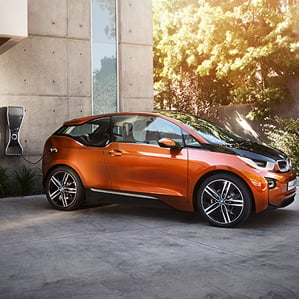BMW’s Solution to Limited Electric-Vehicle Range: a Gas-Powered Loaner
While they wait for cheaper batteries that can store more energy, carmakers are trying a range of strategies to compensate for the shortcomings of existing batteries. One of the latest, coming from BMW for the electric i3 slated to come out this year, is to offer customers loaner cars for long trips (see “BMW Shifts into Electric Gear”).

To compensate for the limitations of current batteries, GM added a gasoline motor—and a complex transmission—to its electric Volt, to allow drivers to take long trips. Tesla, meanwhile, offers very large and expensive battery packs to allow a range more than twice that of the electric Nissan Leaf, and it’s installing a network of fast charging stations that can recharge the batteries most of the way in about an hour. The Tesla Model S with a 265-mile range sells for $80,000.
BMW’s approach is based on several years of field testing with customers of prototype electric vehicles with a range per charge of about 100 miles. The automaker found that range was only a problem with about 10 percent of daily trips. It plans to provide a gas-powered loaner vehicle for these infrequent trips. “We offer you a fallback solution in case you purchase this car and then need to go on a 500-mile trip,” says Rolf Stromberger, BMW’s vice president of business environment and public affairs strategy.
The cost of such a program could be worth it to BMW, if only for the marketing value, says Michael Omotoso, an analyst for LMC Automotive. It would both address customers’ concerns over range limits and prevent potential negative publicity that could come from frustrated drivers. He noted that Tesla’s fast-charger approach suffered a setback after a reviewer who was testing the charging network ran out of power and was stranded (see “Musk-New York Times Debate Highlights Electric-Vehicle Shortcomings”). But he says the economics depend on how the loan program is set up, and how often drivers would use the loaner cars. BMW says the number of times a driver could use a loaner car would be limited each year.
BMW is also offering an optional gas engine on the i3, possibly a two-cylinder motorcycle engine. It would act as a generator to recharge the battery, and would be smaller than the one in the GM Volt. The gas tank will also be smaller, giving the car a total range (battery plus gas-powered) of only 186 miles, compared to nearly 400 miles for the Volt.
Stromberger says the automaker is also making extensive use of carbon-fiber-reinforced plastics to replace steel, lowering the weight of the vehicle and allowing the company to use a smaller, cheaper battery pack (see “Automakers Shed the Pounds to Meet Fuel Efficiency Standards”).
But the car—a small coupe—will still be expensive, costing about as much as the BMW’s larger 5-series sedans, which sell for about $50,000.
Keep Reading
Most Popular
Large language models can do jaw-dropping things. But nobody knows exactly why.
And that's a problem. Figuring it out is one of the biggest scientific puzzles of our time and a crucial step towards controlling more powerful future models.
How scientists traced a mysterious covid case back to six toilets
When wastewater surveillance turns into a hunt for a single infected individual, the ethics get tricky.
The problem with plug-in hybrids? Their drivers.
Plug-in hybrids are often sold as a transition to EVs, but new data from Europe shows we’re still underestimating the emissions they produce.
Stay connected
Get the latest updates from
MIT Technology Review
Discover special offers, top stories, upcoming events, and more.